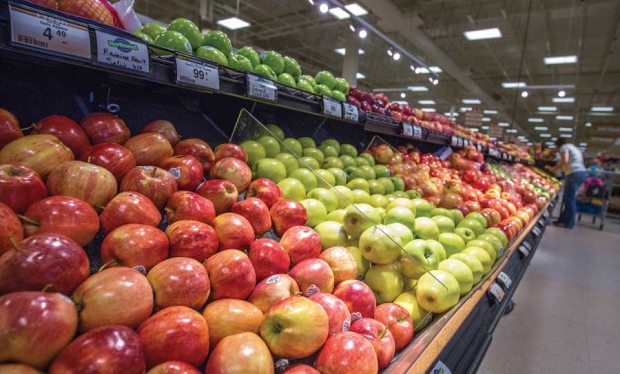
With display space for apples already crowded on retail shelves, will there be space for new varieties coming to market? (TJ Mullinax/Good Fruit Grower)
As growers produce larger crops comprising both mainstay and new varieties, marketers face greater challenges garnering retail shelf space.
Supermarkets are not miraculously getting bigger, and that space has to come from somewhere — either from new varieties, organics or competing products like citrus fruit, according to Steve Lutz, Columbia Marketing International’s vice president of marketing.
Produce space is governed by retailers’ perceptions of consumer preference and what they think they can sell.
And the pressure is on the industry to remain competitive. As an example, Lutz said, look at Budweiser: Sales have fallen roughly 40 percent in the past 20 years — from 49.2 million barrels in 1988 to 17.2 million barrels in 2011 — thanks to the booming craft beer market.
“Go into a grocery store today and look at the beer display. It’s now full of multiple brands,” Lutz said during the 111th Annual Meeting of the Washington State Tree Fruit Association, held in December in Yakima, Washington. “The question is, ‘How will I get it on the shelf, and how will I get it off the shelf once I’ve produced it?’”
Why worry?
The new orchards being planted each year mean there are a lot of young trees with new products and new varieties that will be bearing fruit and competing for space at the retail level, Lutz said. At the same time, consumption has been flat.
“The variety that we offer consumers offers us more opportunities to be successful with our products, but it puts demand on space,” he said. “When we produce the next Cosmic Crisp, where are we going to put it?”
Apple, pear and cherry growers aren’t the only growers producing new varieties, either. Variety is up everywhere — grapes, tomatoes, melons, all major commodities — as well as the growing organic sector.
The Costcos and Sam’s Clubs of the world are unlikely to expand their produce footprint.
Sam’s Club averages seven varieties of apple, but “just try to get an eighth,” Lutz said. “It is very, very difficult. They will say they have an expectation that your product will drive x number of sales per store, per week. If you can’t do that, we don’t want it.”
Plus, as complexity increases in the marketplace, so do mistakes at the retail level, Lutz said. “It’s easy for the retail companies that we rely on to get it wrong, to make mistakes and be less than optimal.”
Driving retail
There’s a relationship between what products pay to a supermarket and what space retailers are willing to offer that product, Lutz said.
Apples have the largest footprint of space at retail, but because of that large footprint, the dollars per square foot are among the lowest of all fruits, posing an even greater challenge to expand that space.
Retailers’ approaches to sales factor in as well.
During the marketing season for Washington’s 2014 record apple crop of 140 million packed boxes, the top 15 supermarket chains sold more apples, but the bottom 15 chains not only lost dollars, they also lost volume, Lutz said.
Weaker-performing retailers tend to focus on a core low price and lack variety in their produce departments, with no new space or new items and no premium selections or upscale packages.
Almost 80 percent of their sales and volume come from Red Delicious, Golden Delicious, Gala, Granny Smith and McIntosh, which means they’re still “approaching the apple category like it’s Budweiser,” Lutz said.
Conversely, top-performing retailers are generating only about 45 percent of their revenue from those five varieties, making greater gains with newer varieties like Honeycrisp, Jazz, Envy, Ambrosia, Cripps Pink and SweeTango.
Strong retailers allocate space to large volumes, with solid premium selections and packaging options. They also leverage organics and organize flow in their departments to steer consumers to higher-value apples.
Lower-performing stores will put a familiar variety of apple for 49 cents per pound next to Honeycrisp at $2.99 per pound. “What message is that sending to the consumer? Buy the cheap apples,” he said. “It’s a self-defeating strategy that is an absolute waste of space.”
Marketers have opportunities in the retail market if they remember that packaging sells and displays matter, Lutz said. “There is a space race going on, but we have spectacular new products coming to market. You have to execute with marketing, and you have to execute with packaging.” •
– by Shannon Dininny






Leave A Comment